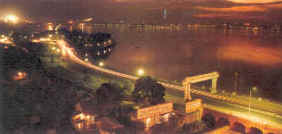
The capital of Andhra Pardesh consist of the twin cities of Hyderabad and Secunderabad and is famous as the former seat of the fabulously wealthy nizams of Hyderabad. Built on the banks of the river Musi, and surrounded by huge prehistoric rock formations like petrified, gray elephants, Hyderabad is a blend of the fairy tale and earthy, a pot pouri of old and new. The domed and minaretted monuments of the Qutub Shahi and Asaf Jha nobility and cheek by jowl with massive grass and concrete high-rises. Banjaran gypsies in swinging skirts and silver ornaments and black-veiled burqua- swathed women dressed in chooridars or jeans. the hilltop pleasure garden where noblemen took their ease now boasts of a brand new observatory. Like Bijapur in neighbouring Karnataka state, Hyderabad is and important centre of Islamic culture and is central india's counterpart to the Mughal splendour of the northern cities of Delhi, Agra and Fatehpur sikri.
Facts of the Hyderabad
Best Season September and February
STD Code 040 History
Hyderabad, india's fifth-largest city, was founded in 1590 by Muhammad Quli, the fourth of the Qutb Shahi kings. They ruled this part of the Deccan from 1512 until 1687, when the last of their line was defeated by the Mughal emperor , Aurangzeb, following nonpayment of the annual tribute to their nominal suzerain in Delhi. Before the founding of Hyderabad , the Qutb Shahi kings ruled from the forted city of Golconda, 11kmto the west. After Aurangzeb's death in 1707, Mughal control over this part of india rapidly waned and the Asaf Jahi viceroys who had been installed to look after the interests of the Mughal Empire broke away to established their own independent state. They give themselves the titles 'subadar' and 'nizam'. These new rulers, allied to the French, became embroiled in the Anglo-French rivalry for control of india during the latter half on the 18th century. When indian independence was declare in 1947, the nizam toyed with idea of declaring, an independent state and allowed and Islamic extremist group to seize control, this led to his downfall. The indian government, unwilling to see an independent and possibly hostile state created in the centre of the Deccan, and mindful of Hyderabad. Now the time has painted Hyderabad all over changing lifestyle and landscape. Opel Astras and Maruti Zens have shoved aside clip-clopping horse-drawn carriages. Elegantly tiled houses, giant archways and many-windowed homes no longer dot the skyline. Flyovers criss-cross busy intersections. The laid-back metropolis is now a science city. For the past 50 years, a lot of water has flown under the Musi.
CultureHyderabad is among the few indian cities which has a well preserved cultural heritage. Very much like the Nawabs of Lucknow and of Awadh ( U.P.), Hyderabad invokes nostalgia among old residents for its culture, fine arts and a certain sophistication in manners. Much more than anything, Hyderabad presents a true picture of secularism. “There is no difference between Islam and Kafir for meâ€, declared Muhammad Quli, “because the basis of all religions is loveâ€. This secularism and its composite culture, in due course created the ethos of Hyderabad. Pt. Jawaharlal Nehru described Hyderabad as a “microcosm of indian culture†and the famous poet Faiz compared Hyderabad to the “Garden of Edenâ€.